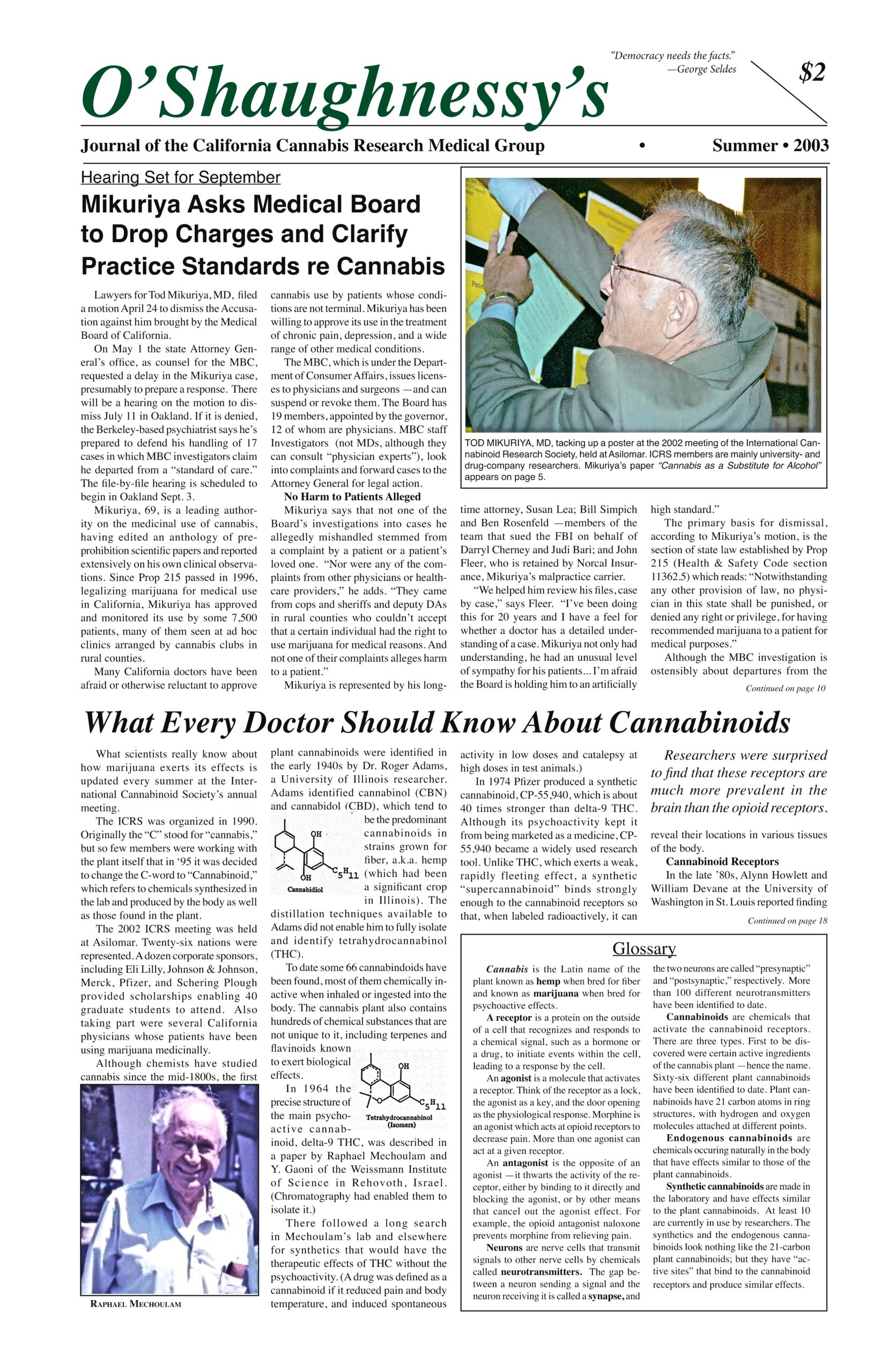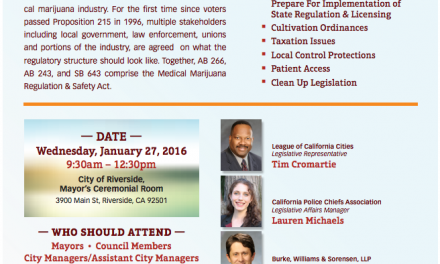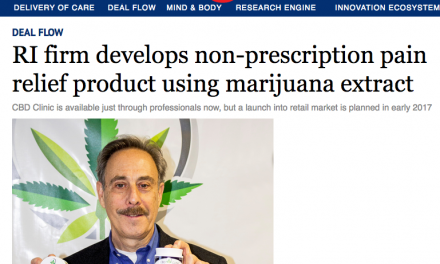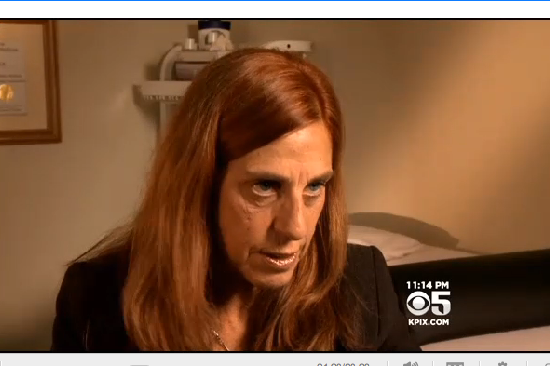In mid-August Dale Gieringer, an SCC stalwart and the longtime director of California NORML, invited some 15 pro-cannabis colleagues, me among them, to a zoom meeting to discuss what had been dubbed “the YMCA Problem” –as in “Youthful Medical Cannabis Abusers.” I didn’t take part in the meetings but I kept up with the emails being exchanged. It was generally agreed that if pot partisans didn’t take some action in response to the YMCA problem, neo-prohibitionists would advance their agenda by publicizing it.
Dale’s project seemed like a good subject for my Anders0n Valley Advertiser column. (The AVA is a Mendocino County weekly that publishes as much or more good material than The New Yorker.) I called Dale to get some details, drafted a piece and sent it to him and Dr Sherry Yafai (to check facts about her practice). I also sent the draft to Dr. Bonni Goldstein, whom I had quoted at length. Dr. Goldstein didn’t like that I was exposing the group’s plan and requested that most of her quote be cut.
This is the piece as published in the AVA Oct. 24:
In mid-August Dale Gieringer, the longtime director of California NORML, invited some 15 pro-cannabis colleagues to a zoom meeting to discuss what had been dubbed “the YMCA Problem” – as in Youthful Medical Cannabis Abusers. An intrepid and principled organizer, Gieringer had decided to take action after hearing Sherry Yafai, MD, say that in the past year she had observed a troubling upsurge in use of extremely potent pot products by young people.
Yafai is an Emergency Medicine physician at Providence St. John’s Medical Center in Santa Monica who, since 2017, has had a cannabis-focused private practice. When she first entered the field, she was the medical director of a sober living program in which patients would substitute cannabis for opioids and other highly addictive and deleterious drugs. Her patients used low or moderate amounts of cannabis to help them stay off their destructive drug(s) of choice. Yafai did not foresee that cannabis itself would become a problem drug and that “Cannabis Use Disorder” would become widespread among young people. But she was quick to pick up on the trend and to understand how online “recommendation mills” were enabling under-21-year-olds to buy high-THC products (both edibles and high-potency vape pens) at dispensaries that presumably catered to medical users.
Gieringer’s invitees formed an “Underage Inappropriate Access Working Group” to devise a strategy for coping with the YMCA phenomenon. Bonni Goldstein, MD, responded to the first wave of tactical suggestions with the incisive critique quoted below. Goldstein had been a pediatrician for years before becoming a cannabis specialist, and her patients are mostly severely ill children with epilepsy, cancer, and autism. She never ignores economic reality.
1) I am 100% against any requirement for those under 21 to have to get the state card as this means that my pediatric patients, which for the most part are the sickest of the sick with cancer, intractable epilepsy and severe autism (all of which costs a fortune out of pocket), will have to spend another $150 per year ($100 for patient plus $50 for caregiver for the card) because of the bad players taking advantage of the system.
2) I am also against higher taxes on higher THC products. Many of my autism and cancer patients are using high doses of THC tincture/concentrated oils (>25%THC) in addition to other cannabinoids and should not be financially penalized for this appropriate medical use of THC. Additionally many chronic pain patients who have been able to discontinue opioids with use of concentrates would be negatively affected by added taxes. (Remember pain pills are paid for by insurance; we should try to support those who have been able to lower or discontinue pain meds, not raise taxes on them.)
3) I have previously mentioned my resistance to putting dosing on recommendations, as first this is akin to a prescription (illegal), but additionally, this will be very challenging logistically. Most patients have to try different products/dosages to find what works. Changing specific dosing on a frequent basis (which is typical when someone initiates a medical cannabis regimen) creates a burden for both physicians and patients.
By September the group had decided to alert the Medical Board of California to the impact of the recommendation mills, hoping that they would take appropriate action. Goldstein, with input from Yafai and Jeffrey Hergenrather, MD, are drafting a letter to Attorney General Rob Bonta. (The AG’s office prosecutes doctors who run afoul of the med board.) Governor Gavin Newsom will be cc’ed. Both he and Bonta had a hand in making cannabis “legal” in California – an obvious fiasco. Both are ambitious. An epidemic of “Cannabis Use Disorder” among young people might tarnish their images.
Retrograde Messages
In Tod Mikuriya’s paper on Cannabis as a Substitute for Alcohol – probably the best thing that will ever be written on the subject – he cites a British psychiatrist named Carstairs who in 1951 studied the two highest castes in a large village in Northern India, the Rajputs (warriors and governors who drank a potent distilled alcohol called daru) and the Brahmins (religious leaders who were vegetarians and drank a cannabis infusion called bhang). Mikuriya observed: ”The disinhibition achieved via alcohol is the Rajput kind — a flight from reality, becoming ‘blotto’ — whereas the disinhibition achieved via cannabis is the result of focused or amplified contemplation.”
Mikuriya’s great paper was published in 2003, long before the movement morphed into The Industry. Nowadays, manufacturers are producing super-strong cannabis products that can make the user blotto – the effect many YMCAers want to achieve.
Among US teenagers, there’s a terrible epidemic of despair. Girls are slashing themselves and killing themselves. More than one in 10 US schoolchildren have ADHD diagnoses. One in 12 boys is a sociopath, according to a Rhode Island state health official. One in 44 US children have been diagnosed with ASD (Autism Spectrum Disorder). Only one in four are fit to serve in the military at age 18. Most who “volunteer” are fleeing futures devoid of hope. Even the middle-class kids and the rich kids know that Eden is burning.
What percentage of teenage girls who slash themselves are heavy cannabis abusers? The study will never be conducted because nobody stands to make money by learning the results. What percentage of teen suicides are heavy cannabis abusers? The sad reality is that YMCAers are people who desperately want to get fucked up. And if they can’t do it on megadoses of THC, they’ll find some other way. Most of the available methods – alcohol and opioids – are more deleterious than 100 milligrams of THC.
Dale Gieringer agrees that the upsurge in high-dosage marijuana intake “might be related to the national malaise. On the other hand,” he insists, “18 year olds shouldn’t be going into dispensaries and buying ‘shatter’ on medical recommendations since those substances aren’t even medically prescribable. The doctors say they would never recommend dabbing or high-potency hashish except in severe cases of childhood epilepsy and cancer, when they might prescribe 100 milligram capsules. They wouldn’t prescribe these other things that give you a huge rush.”
There’s no arguing with that. But sometimes I think if it wasn’t for unintended consequences there wouldn’t be any consequences at all.
The SCC and the MBC
Leaders depart, new circumstances arise, and organizations always change –whether or not they acknowledge the changing. Some institutions turn into the opposite of what the founder had aimed for. Look at what St. Paul did to the teaching of Jesus, or what Stalin did to Marx. The Society of Cannabis Clinicians honors its founder, Tod Mikuriya, MD, but our political line vis-a-vis the Medical Board of California is now markedly different from his. This review of O’Shaughnessy’s coverage of the SCC-MBC relationship over the years is provided only by way of historic memory.
After Prop 215 passed in 1996, Attorney General Dan Lungen (who had led the opposition and whose office prosecutes doctors who run afoul of the medical board), targeted Tod, a co-author of the initiative. The board investigated him based on complaints from cops and sheriffs up and down the state. There had been no complaints against him from patients or their loved ones or from other caregivers. Many narcs took their loss of power personally, as if the new law had caused them to lose face. California growers got doctors’ letters of approval and stopped cowering. It was a brief, shining moment.
At first Tod was virtually alone in his willingness to approve marijuana use for conditions less grave than AIDS, cancer, and epilepsy. Many California MDs knew from their patients that marijuana was safe and effective in treating a wide range of conditions. But their professional educations had been very extensive and expensive, and their livelihood depended on a license issued by the state medical board. Decades of Total Prohibition weighed heavily on every doctor’s mind. As the 21st century dawned, Tod invited eight brave colleagues to join the California Cannabis Research Medical Group (which became the SCC in 2005). He was being investigated by the med board at the time, seven of the CCRMG’s charter members would be similarly scrutinized. Few were put on probation, but just being investigated meant hiring a lawyer and devoting time and focus to the looming threat.
Tod was disappointed that Bill Lockyer, the supposedly liberal Democrat who had succeeded Lungren as Attorney General in ’98, did not call off his prosecution. An administrative law judge would find that Mikuriya had violated the board’s “standard of care.” Unwilling to accept Probation, he appealed at the state-court level. His line on Lockyer and other politicians who merely feigned support for the medical marijuana movement was: “We’ve got to hold their feet to the fire.”
Tod saw the emerging field of cannabis medicine as a new specialty that called for a journal in which clinicians could share findings and be kept abreast of relevant scientific and political developments. In 1999 he asked my help in producing “a cross between a medical journal and a defense committee leaflet.” I was being offered post position on a major story of our time and I could hold onto my day job as managing editor of Synapse, the UCSF weekly. Using Pagemaker I began laying out articles and graphics for the massive publication Tod was calling the “Medical Marijuana Review.” It would be a four-column tabloid –the same as Synapse. We ran off a few copies for Tod to distribute to patients.
In November ’99, Terence Hallinan was re-elected District Attorney of San Francisco and asked me to be his press secretary and help implement Prop 215 in the city. I spent a few interesting years in law enforcement and then left to help Tod launch the journal he would name O’Shaughnessy’s
Below is the front page of our first issue (Summer 2003, with color photos replacing B&W). It was printed at Howard Quinn, a union shop in the Mission District. Tod paid for a press run of 15,000 and to my surprise, they all got distributed by his colleagues and at dispensaries.

“Mikuriya Asks Medical Board to Drop Charges and Clarify Practice Standards re Cannabis” was the top headline on the front page. Beneath it ran “What every doctor should know about the cannabinoids,” which introduced pot partisans the endocannabinoid system and broke the CBD story. Although the corporate media would continue to define THC as “the active ingredient in marijuana” for years to come, we knew better. The science side of the story was fascinating, and it was exciting to extend our education in adulthood.
In those early days of legalization for medical use, almost everybody seeking physician approval had already been using marijuana. “Conferring legitimacy” is how Tod described the most useful thing he and his colleagues did for patients. He regarded every legal pot smoker as a participant in a political movement and the MDs issuing approvals as de facto organizers.
An enduring mystery is: why didn’t the MBC crack down on the quick-buck artists 15 years ago? Were they so blinded by Drug War propaganda that they couldn’t see the difference between Tod and his small band of serious “cannabis clinicians” and the hustlers on Venice Beach or the scantily clad Dr. Patel? Were the Prohibitionist strategists so politically astute that they figured highly publicized “clinics” on the Venice Beach boardwalk would discredit the marijuana movement? Highly unlikely, although John Lovell, their top lobbyist in this period was no fool.
I’m grateful to Dr. Robinson for pushing me to make material from our back issues online. I hate to put articles behind a pay wall, but economic necessity now outweighs my hope of reaching the masses. In a month or so we can offer free access as a perk for SCC membership.
CMA, Patients Join Push for Guidelines
California Medical Board Adopts Practice Standards
The Case Against Tod Mikuriya, Continued
Cannabis Clinicians Oppopse FSMB ‘Model Guidelines’
Med Board Will Discuss MJ With Cannabis Clinicians… Someday
Med Board to Hear About CBD Rescheduling
SCC Creates Decision Tree for MDs Treating Neuropathic Pain Patients
https://beyondthc.com/ca-med-board-to-review-mmj-guidelines-on-4-20/
Cannabis Clinicians Oppose Model Guidelines
Cannabis Via ‘TeleHealth’ 2016
Note to the MBC Marijuana Task Force 2/8/17
https://beyondthc.com/know-your-med-board/
MBC Revises Guidelines re Cannabis Approvals
https://beyondthc.com/ca-med-board-revises-guidelines-re-cannabis-approvals/
Newsom Keeps Favorites on MBC (SF Chronicle piece)
MBC to assess “impact of cannabis use on physicians”
Notes on the MBC Marijuana Task Force Meeting
‘Protesting the MBC’s ‘Agreement’ 9/17
Speller, Ragland Curtailed by MBC
Dr. Grant Enlightens MBC Too Late (Neoprobe Guidelines Approved)
MBC Revises Guidelines re MMJ Approvals
SCC Exposes Deceitful JAMA Op-ed
Bonus Tracks
Here’s somelightly outdated MBC Gossip from Jenny Gold, Kaiser Health News
The president of the Medical Board of California is facing questions from critics about a business deal he struck after the board decided to reinstate the license of a doctor who engaged in sexual misconduct with patients.
In 2012, Dr. Dev GnanaDev, new to the board and not yet president, was part of a disciplinary panel that voted to reinstate Dr. Hari Reddy. The Victorville family physician had lost his license in 2003 after the board found he had engaged in sexual misconduct with four female patients, including a minor.
About a year after the 2012 vote, GnanaDev sought a donation from one of Reddy’s relatives to start a new medical school in California’s Inland Empire, GnanaDev confirmed. Dr. Prem Reddy, Reddy’s brother-in-law, agreed to put $40 million into the nonprofit venture.
[The following brief bio ran on the MBC site when Dev GnanaDev, MD of Upland, was appointed to the Medical Board. “He serves as chair of the Department of Surgery at Arrowhead Regional Medical Center, a position he has held since 1989. He is a clinical professor of surgery at Western University for Health Sciences and an associate professor of surgery at Loma Linda University. He served as president of the California Medical Association from 2008 to 2009. Dr. GnanaDev has received a multitude of honors and recognition for his outstanding work and commitment to those who utilize public health programs, including the Medical Board’s Physician Recognition Award in February 2005. He earned his medical degree from the Kurnool Medical College in Kurnool, Andhra Pradesh, India.”]
A bit about the current chief: Kristina Daniel Lawson, of Walnut Creek, has been appointed to the Medical Board of California. Lawson is a partner at Manatt, Phelps and Phillips, LLP in San Francisco, where she practices land use and environmental law. Lawson was a member of the Walnut Creek City Council from 2010 to 2014, and served as Walnut Creek’s Mayor in 2014. Lawson earned a Juris Doctor degree from the Santa Clara University School of Law, and a B.A. from the University of Arizona.
Dr. Robinson recently forwarded two pieces relevant to the medical board(s). This one by Jennifer Hudson of MedPage today summarizes a major story in the muckraking journal Mother Jones:
Medical Boards ‘Stacked With Republican Donors’
Medical boards are not necessarily nonpartisan organizations, according to reporting from Mother Jones. Boards are “stacked with Republican political donors” in certain states that have recently tightened restrictions on abortion, Mother Jones reported.
Across 12 states with total or near-total abortion bans as of the end of last month, more than half of medical board seats were held by individuals who had given at least $1,000 each to Republican campaigns, Mother Jones reported, citing campaign finance data accessed through the National Institute on Money in Politics that was analyzed by the outlet. And about 70% are men, Mother Jones further noted.
“In the post–Roe v. Wade reality, boards long seen as doctors’ allies are being recast as something to fear: panels of political appointees armed with wide- reaching abortion bans and the power to strip doctors of their licenses,” Mother Jones wrote.
Adarsh Krishen, MD, chief medical officer for Planned Parenthood of Greater Ohio, explained to Mother Jones that, “The more zealous people you get on the board who have extreme views, the more likely it is that the state medical board is going to more tightly align with the other arms of the government and go after physicians.”
In a number of states, medical boards are “being used as the muscle behind new restrictions,” Mother Jones reported. Even if a local prosecutor has pledged not to file criminal charges against physicians performing abortions, the prospect of medical board discipline may be enough to scare them away from delivering care, Mother Jones reported.
Medical board discipline “happens state by state,” Mother Jones wrote. However, “it’s designed to follow a doctor throughout her career,” with malpractice insurers, prospective employers, and medical boards in other states where a physician holds a medical license being informed of it.
And this piece from STAT News by Tara Bannow:
Private Equity Profits by ‘Short-Changing’ Children With Autism
A popular form of autism therapy called applied behavior analysis (ABA) is meant to cut down on unwanted behaviors as well as improve language and social skills. However, more than three dozen families, clinicians, and experts interviewed by STAT identified recent red flags with the provision of ABA, the outlet reported.
Some of the individuals interviewed said that providers of ABA used cookie-cuttertemplates instead of individualized treatment plans, and many parents said that they had been hounded to bring their children to more therapy, STAT reported. Nearly all of the individuals pointed to a severe provider shortage and constant turnover, “depriving kids with autism of the thing they need most: consistency,” the outlet added.
All the while, ABA, long viewed as the gold standard for children with autism, is the only option that insurance will cover for some families, STAT noted.
“But like other pockets of the health care industry, this one has been transformed over the past decade by a flood of investments from private equity firms, drawn by the promise of insurance reimbursement and the rising rate of autism in children across the U.S., now estimated at 1 in 44 kids,” STAT wrote.
Families and clinicians who once fully believed in ABA told STAT that private equity’s “fixation of profit” has “degraded the quality of services kids receive, turning it into the equivalent of fast food therapy,” the outlet wrote.
“Bad ABA can at worst traumatize and injure a child,” Michele Trivedi, MHA, who manages The Arc of Indiana’s Insurance Advocacy Resource Center and whose daughter has autism, told STAT.
“At best, you’ve wasted that child’s time, you’ve wasted that family’s time, you’ve wasted a lot of their money because they’re paying copays,” Trivedi further told STAT. “You’ve wasted the health insurer’s money, taxpayers’ money. This is not a victimless crime.” However, ABA providers countered to STAT that they are not failing to provide individualized treatment plans. They said that tailoring services to each client is their top priority and that financial investors don’t dictate the hours they prescribe.
Some providers told STAT that they are struggling with staff shortages and high inflation, and that they are trying to get health insurers to pay more for services.





